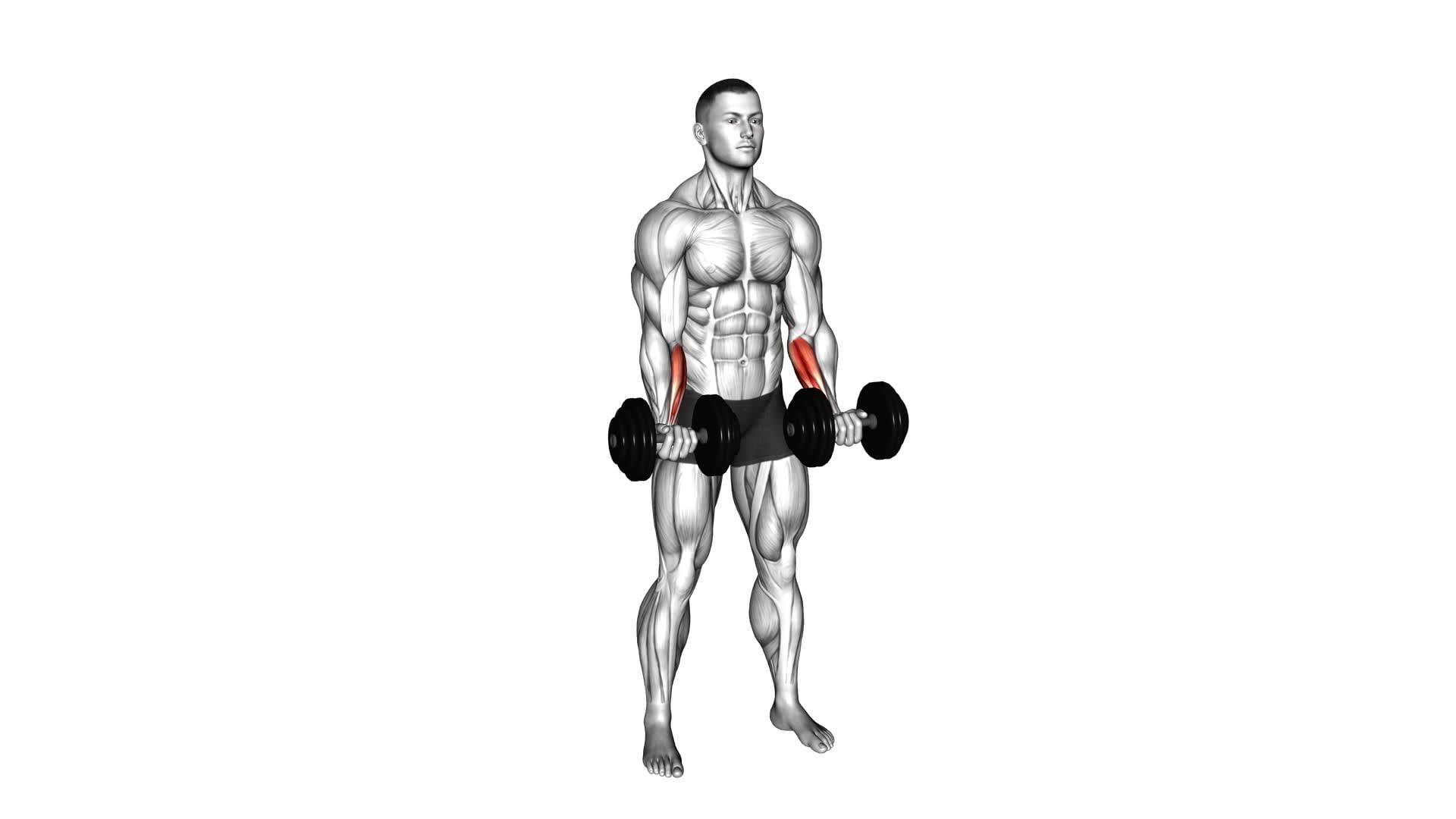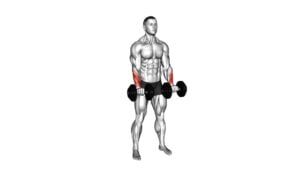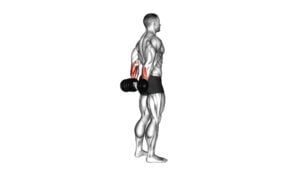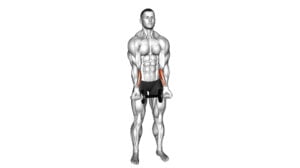Dumbbell Standing Wrist Curl – Video Exercise Guide & Tips

Looking to strengthen your wrists and forearms? The dumbbell standing wrist curl is the exercise for you.
Watch This Exercise Video
In this video exercise guide, we'll show you the proper form and technique to maximize your results.
Learn about the benefits, variations, and progressions of this exercise, as well as common mistakes to avoid.
Follow our tips and incorporate the dumbbell standing wrist curl into your workout routine for stronger, more resilient wrists.
Let's get started!
Key Takeaways
- Dumbbell standing wrist curls improve grip strength and enhance overall wrist flexibility.
- They help prevent wrist injuries during weightlifting and are beneficial for activities like weightlifting and rock climbing.
- Proper form and technique are important to avoid mistakes and wrist injuries.
- To maximize results, use controlled motion, engage core muscles, start with lighter weights, and gradually increase weight over time.
Benefits of Dumbbell Standing Wrist Curls
There are three main benefits you'll experience when performing dumbbell standing wrist curls.
First, this exercise is highly effective in improving grip strength. By focusing on the muscles in your forearms and wrists, dumbbell standing wrist curls help to increase the strength and endurance of the muscles responsible for gripping objects. This can be extremely beneficial in various activities such as weightlifting, rock climbing, and even everyday tasks that require a strong grip.
Secondly, performing dumbbell standing wrist curls can help prevent wrist injuries during weightlifting. By strengthening the muscles in your wrists, you provide additional support and stability to the joint, reducing the risk of strain or sprain. This is particularly important when lifting heavy weights or performing repetitive movements that put stress on the wrists.
Lastly, incorporating dumbbell standing wrist curls into your workout routine can help improve overall wrist flexibility. The exercise involves a controlled range of motion, which helps to stretch and strengthen the muscles and tendons in your wrists, allowing for greater mobility and reducing the likelihood of stiffness or discomfort.
With these benefits in mind, let's now move on to discussing the proper form and technique for dumbbell standing wrist curls.
Proper Form and Technique for Dumbbell Standing Wrist Curls
To perform dumbbell standing wrist curls with proper form and technique, follow these steps:
- Grasp a dumbbell in each hand and stand with your feet shoulder-width apart.
- Start by holding the dumbbells in an overhand grip, with your palms facing down.
- Keep your arms straight and close to your body, with your elbows slightly bent.
- Slowly curl your wrists upward, bringing the dumbbells towards your body, while keeping your forearms stationary.
- Pause for a second at the top of the movement.
- Slowly lower the dumbbells back down to the starting position.
Proper form and technique are crucial to prevent common wrist injuries and get the most out of this exercise. Here are some tips to keep in mind:
- Avoid using excessive weight, as this can strain your wrists.
- Focus on maintaining a controlled and smooth motion throughout the exercise.
- Keep your wrists relaxed and avoid any jerking or swinging motions.
- If you have limited wrist flexibility, consider incorporating wrist flexibility exercises into your routine to improve mobility and reduce the risk of injury.
Variations and Progressions for Dumbbell Standing Wrist Curls
Now that you have mastered the proper form and technique for dumbbell standing wrist curls, it's time to explore some variations and progressions to further challenge your wrists and forearms.
One option is to try different grip variations, such as using an overhand grip or an underhand grip, to target different muscles and add variety to your workout.
Another way to progress is by gradually increasing the weight increments, allowing your muscles to adapt and grow stronger over time.
Additionally, you can add resistance bands to increase the resistance and intensity of the exercise, providing an extra challenge for your wrists and forearms.
Modified Grip Options
When performing the dumbbell standing wrist curl exercise, you can modify your grip to add variations and progressions. Here are some modified grip techniques that can help you target different muscles and increase the intensity of your wrist strengthening exercises:
- Overhand Grip: Hold the dumbbell with your palms facing down. This grip primarily targets the flexor muscles in your forearms.
- Underhand Grip: Hold the dumbbell with your palms facing up. This grip primarily targets the extensor muscles in your forearms.
- Alternating Grip: Alternate between the overhand and underhand grips for each repetition. This grip helps to balance the workload between the flexor and extensor muscles.
- Wide Grip: Hold the dumbbell with your hands wider apart. This grip places more emphasis on the outer muscles of your forearms.
By incorporating these modified grip options into your routine, you can challenge your muscles in different ways and continue to make progress.
Now, let's move on to the next section about increasing weight increments.
Increasing Weight Increments
To increase the intensity of your dumbbell standing wrist curls, you can gradually add more weight to challenge your muscles and promote progress. However, it's important to do so safely and prevent wrist injuries.
When increasing weight, start by adding small increments, such as 2-5 pounds, to allow your muscles and wrists to adapt gradually. This will minimize the risk of strain or injury.
As you become comfortable with the added weight, you can continue to increase it over time. Remember to maintain proper form and technique throughout the exercise, keeping your wrists straight and avoiding excessive bending or twisting.
Listen to your body, and if you experience any pain or discomfort, reduce the weight or consult a professional for guidance.
Adding Resistance Bands
To further challenge your muscles and enhance the effectiveness of your dumbbell standing wrist curls, you can incorporate resistance bands into your routine. Resistance band exercises offer a variety of benefits and can take your wrist curls to the next level.
Here are a few ways to add resistance bands to your dumbbell standing wrist curl routine:
- Attach one end of the resistance band to a stable object, such as a squat rack or a heavy dumbbell, and the other end to your wrist. This will provide additional resistance throughout the exercise.
- Loop the resistance band around your wrist and hold onto the ends while performing the wrist curl. This will create constant tension on your muscles, increasing the difficulty.
- Combine the dumbbell and resistance band by holding the dumbbell in one hand and looping the resistance band around your wrist. This will challenge your muscles in different ways and improve overall strength and stability.
- Gradually increase the resistance of the band as you get stronger to continue challenging your muscles and promoting growth.
Incorporating resistance bands into your dumbbell standing wrist curl routine can help you build stronger wrists and forearms, improve grip strength, and increase overall muscle activation.
Common Mistakes to Avoid During Dumbbell Standing Wrist Curls
When performing dumbbell standing wrist curls, it's important to avoid common mistakes that can hinder your progress and potentially lead to injury.
One common mistake is incorrect wrist positioning, such as allowing the wrists to bend too far forward or backward. This not only reduces the effectiveness of the exercise but also puts unnecessary strain on the wrists.
Another mistake to avoid isn't using proper form, such as using excessive momentum or swinging the weights. By maintaining control and proper form throughout the exercise, you can maximize the benefits and minimize the risk of injury.
Incorrect Wrist Positioning
While performing dumbbell standing wrist curls, it's important to avoid incorrect wrist positioning. Here are some common mistakes to avoid and workout modifications to ensure proper wrist alignment:
- Bending the wrists: Don't bend your wrists excessively during the exercise. Keep them in a neutral position to prevent strain and injury.
- Cocking the wrists: Avoid cocking your wrists back during the curl. This places unnecessary stress on the joints and can lead to discomfort or pain.
- Lifting too heavy: Using excessively heavy dumbbells can cause your wrists to bend or strain. Start with lighter weights and gradually increase as your strength improves.
- Not using full range of motion: Ensure that you're moving your wrists through their full range of motion during the exercise. This will engage all the muscles in the forearm and maximize the benefits of the workout.
Not Using Proper Form
To avoid not using proper form during dumbbell standing wrist curls, you should be mindful of your technique and avoid these common mistakes. Using improper form can lead to potential injuries and decrease the effectiveness of the exercise.
One of the most important aspects of proper form in wrist exercises is maintaining a neutral wrist position throughout the movement. This helps to prevent strain on the wrists and ensures that the targeted muscles are being properly engaged.
Another mistake to avoid is using excessive weight, as this can cause you to compromise your form and put unnecessary stress on your wrists and forearms.
It's also important to perform the exercise in a slow and controlled manner, avoiding any jerking or swinging motions.
Tips for Maximizing Results With Dumbbell Standing Wrist Curls
To maximize results with dumbbell standing wrist curls, focus on maintaining proper form and gradually increasing the weight. Here are some tips to help you get the most out of your wrist curl workouts:
- Use a controlled motion: Slowly lift the dumbbell using your wrist muscles, then lower it back down in a controlled manner. Avoid swinging or using momentum to lift the weight, as this can reduce the effectiveness of the exercise.
- Engage your core: Keep your core muscles engaged throughout the exercise to maintain stability and prevent unnecessary strain on your lower back.
- Start with lighter weights: Begin with a weight that allows you to perform the exercise with proper form and without excessive strain. As your strength improves, gradually increase the weight to continue challenging your muscles.
- Incorporate wrist flexibility exercises: Before performing wrist curls, warm up your wrists with some flexibility exercises. This can help increase your range of motion and improve the effectiveness of the wrist curls.
Sample Workout Routine Incorporating Dumbbell Standing Wrist Curls
To incorporate dumbbell standing wrist curls into your workout routine, consider the following sample workout.
Start by warming up with five to ten minutes of light cardio, such as jogging or cycling, to get your blood flowing and prepare your muscles for the workout.
After warming up, begin your upper body routine with compound exercises like bench presses and shoulder presses to target multiple muscle groups.
Once you've completed your compound exercises, it's time to incorporate wrist curls into your routine.
Perform three sets of 12-15 reps of dumbbell standing wrist curls. Stand with your feet shoulder-width apart, holding a dumbbell in each hand with an underhand grip. Keep your arms extended in front of your thighs and curl your wrists towards your body, squeezing your forearms at the top of the movement. Lower the dumbbells back down to the starting position and repeat for the desired number of reps.
To maximize the benefits of this exercise, make sure to maintain proper form throughout each set. Keep your core engaged and avoid using momentum to lift the weights. If you find that the dumbbells are too heavy, you can decrease the weight or perform the exercise with one arm at a time. Remember to listen to your body and adjust the weight and reps as needed.
Incorporating dumbbell standing wrist curls into your upper body routine can help strengthen your forearm muscles and improve grip strength.
Frequently Asked Questions
How Many Sets and Reps Should I Do for the Dumbbell Standing Wrist Curls?
For the dumbbell standing wrist curls, you should aim for 3 sets of 12-15 reps. This exercise is great for strengthening your forearm muscles and improving grip strength.
If you're looking for alternative exercises, you can try the barbell wrist curls or the reverse wrist curls. Wrist curls not only target the muscles in your forearms but also help with wrist stability and injury prevention.
Incorporating wrist curls into your routine can have many benefits for your overall fitness.
Can I Use Wrist Straps or Gloves While Performing Dumbbell Standing Wrist Curls?
Yes, you can definitely use wrist straps or gloves while performing dumbbell standing wrist curls. Using wrist straps or gloves can provide added support and stability to your wrists, preventing any potential strain or discomfort during the exercise.
They can also help improve your grip on the dumbbells, allowing you to focus more on the targeted muscles and perform the exercise with proper form.
Are There Any Alternatives to Dumbbell Standing Wrist Curls for Targeting the Same Muscles?
Looking for alternatives to dumbbell standing wrist curls?
There are a few exercises you can try to target the same muscles. One option is the barbell wrist curl, which allows for heavier weights.
Another alternative is the cable wrist curl, providing constant tension throughout the movement.
Both exercises offer similar benefits to wrist curls, helping to strengthen the forearms and improve grip strength.
Give them a try and see which one works best for you!
How Long Should I Rest Between Sets of Dumbbell Standing Wrist Curls?
To properly perform dumbbell standing wrist curls, it's important to know how long you should rest between sets. Resting between sets allows your muscles to recover and prevents injury.
The ideal rest time for dumbbell standing wrist curls is usually around 60-90 seconds. However, this may vary depending on your fitness level and goals.
It's always a good idea to listen to your body and adjust the rest time accordingly.
Can I Perform Dumbbell Standing Wrist Curls With Both Arms Simultaneously, or Should I Do One Arm at a Time?
You can perform dumbbell standing wrist curls with both arms simultaneously or one arm at a time. There are advantages and disadvantages to each approach.
Performing the exercise with both arms simultaneously allows for a more efficient workout, targeting both wrists at once. However, it may be more challenging to maintain proper form and control.
Doing one arm at a time allows for better focus and isolation of each wrist, but it may take longer to complete the exercise.
Conclusion
In conclusion, the dumbbell standing wrist curl is a valuable exercise for strengthening and toning the wrists and forearms.
By maintaining proper form and technique, avoiding common mistakes, and incorporating variations and progressions, you can maximize the benefits of this exercise.
Remember to start with lighter weights and gradually increase the resistance as you build strength.
By including the dumbbell standing wrist curl in your workout routine, you can achieve stronger wrists and improved grip strength.

Author
Years ago, the spark of my life’s passion ignited in my mind the moment I stepped into the local gym for the first time. The inaugural bead of perspiration, the initial endeavor, the very first surge of endorphins, and a sense of pride that washed over me post-workout marked the beginning of my deep-seated interest in strength sports, fitness, and sports nutrition. This very curiosity blossomed rapidly into a profound fascination, propelling me to earn a Master’s degree in Physical Education from the Academy of Physical Education in Krakow, followed by a Sports Manager diploma from the Jagiellonian University. My journey of growth led me to gain more specialized qualifications, such as being a certified personal trainer with a focus on sports dietetics, a lifeguard, and an instructor for wellness and corrective gymnastics. Theoretical knowledge paired seamlessly with practical experience, reinforcing my belief that the transformation of individuals under my guidance was also a reflection of my personal growth. This belief holds true even today. Each day, I strive to push the boundaries and explore new realms. These realms gently elevate me to greater heights. The unique combination of passion for my field and the continuous quest for growth fuels my drive to break new ground.







